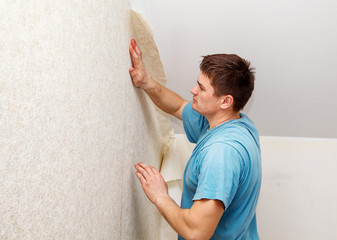Wallpaper is a great way to add personality to plain furniture. Wallpaper is especially effective on pieces with clean lines and simple silhouettes. You can even use textured wallpaper to add interest to a piece. There are several types of wallpaper, so you can choose one that suits your style and your space. To begin your project, choose a design theme for your room. Then, decide how bold or subtle you want the wallpaper to be. If you’re not sure which type to go for, try experimenting with patterns to see which ones look best. You can also Visit Website and check out more wallpaper installation guides.

If you’re planning on applying wallpaper yourself, be sure to read the instructions carefully. Gluing wallpaper to a wall can be a bit tricky. When applying wallpaper, remember to line it up with a straight line and leave two inches of the paper above the ceiling. You can also use a paintbrush to apply the paste to the wallpaper. Just make sure you keep the seams straight and don’t overlap them. This will make the process easier.
If you’re installing wallpaper over an existing floor covering, make sure to measure the length of each wall section. Remember that wallpaper seams should be butted, rather than overlapped so that the edges are less visible. Start your installation opposite the most frequently used entrance and the plumb line. After ensuring you’ve measured the length of the wall, start installing the wallpaper panels. Make sure to mark the height and width of the wallpaper, as well as the corners.
Cut strips of wallpaper to the correct length. You want to get the width of the wallpaper strip, which should be equal to the wall height plus two to three inches. However, don’t cut the length of the wallpaper strip too short because trimming will affect the placement of the next strip. Once you’ve cut the first strip, be sure to wet the wallpaper according to the instructions provided by the manufacturer. Be sure to book the wallpaper strips as you go along, as this will make the adhesive sticky.
If you’re worried about commitment, consider non-woven wallpaper. This type of wallpaper is breathable and washable. Additionally, it’s easy to remove. Most types of non-woven wallpaper come off the wall in a long strip, so you can remove it for structural work or if you want to switch out your walls. You can even reuse pieces of non-woven wallpaper to change a room’s color scheme. These advantages make this type of wallpaper the perfect choice for those with limited space or who desire a more durable option.
Purchasing the right tools is essential before you begin the wallpaper installation process. It will save you time and frustration by not having to run out of a tool. Remember to clean any slick surfaces with TSP before you start. If you’re working in a bathroom or kitchen, you should also hire a professional installer. Certain types of wallpaper are best left to a professional. The type of wallpaper and the complexity of the application determine when it’s time to call in a professional.
Before you begin your wallpaper installation project, be sure to measure the width and height of each wall. Then, find the midpoint on each wall. Use the plumb line as a guideline when applying wallpaper. If your wall is too short or too wide, you may need to make adjustments before reinstalling the wallpaper. You should also repair any nail holes. If you’re installing a larger piece, make sure to measure the width and height of your walls.
Before you begin laying down the new wallpaper, you should make sure the wall is clean, dry, and smooth. Use a wallpaper liner if necessary. If your old wall covering is already damaged, you may need to remove it. Otherwise, if you’re installing a new wall covering, you may have to remove the old one or patch it with sand. Be sure to remove any electrical coverings first. After this, it’s time to prime the wall with wallpaper primer.
The most classic use for wallpaper is to cover all of the walls in the room. If you’re looking to make your wallpaper installation as easy as possible, consider looking at contemporary colors, patterns, and styles. A bold graphic wallpaper will look stunning, while a subtle texture will create a subtle yet striking effect. Remember that wallpaper is an investment, so make sure you choose a design that suits your style. If you’re redecorating frequently, don’t spend too much time on the task.